If you’re interested in building User Interfaces (UIs), you’ll likely want to learn React. However, figuring out where to start can be challenging. There are multiple levels ranging from beginner to advanced. What’s more, there are a handful of elements that make it different from other libraries and frameworks.
The good news is that there are plenty of resources out there that can help simplify the learning process. With the right knowledge, tools, and guidance, you can gain a sound understanding of React. That way, you can start using it in your development projects.
In this post, we’ll explain what React is and discuss the benefits of learning it. Then, we’ll go over some skills and topics to review before you can explore React. Finally, we’ll provide you with information and resources that you can use to learn React as fast (and affordably) as possible. Let’s jump in!
An Introduction to React
React is a JavaScript library for building user interfaces and front-end applications:

It lets you create reusable components so that your code is easy to read and maintain. When paired with a tool like Webpack, React can be used to build single-page applications and static websites.
It’s also important to note that React is declarative. That means it uses a more natural way of describing what should be displayed on the screen. This makes your code easier to debug. Additionally, since React is component-based, you can more easily manipulate and reuse small, independent pieces in different parts of your application.
Furthermore, there are a number of features that make React suitable for building UIs. One is JSX, a syntax extension to JavaScript that lets you write HTML-like code inside your JavaScript files. This makes your code even more readable and even easier to work with.
Another is virtual Direct Object Modeling (DOM). The virtual DOM is a representation of the actual DOM in memory. React uses this to figure out which parts of the UI need to be updated when state changes occur. It makes React applications more performant than those that use the full DOM.
Why You May Want to Learn React
React is a popular choice for building UIs for a handful of reasons. It offers a number of benefits, including that it:
- Produces clean, readable code
- Is easy to debug and find errors in your code
- Makes it simple to create reusable components
- Offers an excellent way to structure your code
Moreover, React is different from other frameworks or libraries because it uses a declarative paradigm instead of an imperative one. In React, you describe what your UI should look like, and React takes care of updating the UI when the underlying data changes.
This approach makes it easy to create complex UIs without having to write much code. It also makes it easy to reason about your code. This, as we mentioned before, makes debugging and maintenance simpler.
Furthermore, React is designed to be extensible, so you can create your own custom components and use them in your application. It’s also open source, so you can use it for free.
What to Learn Before React
Before learning React, there are a few things developers should have a working knowledge of first. Let’s take a look at some of the most important:
- JavaScript: React is a JavaScript library, so it’s important that you learn JavaScript have a good understanding of the language before you start.
- HTML and CSS: Learning HTML and CSS is strongly recommended for learning React since its applications are typically written in HTML and CSS.
- Git: React applications are often stored in a Git repository, so it’s important to understand how to use this version control system.
- Webpack: As we mentioned, Webpack is a tool that can be used to bundle your React application into a single file for deployment.
- Babel: Babel is a tool that can be used to transpile your React code into JavaScript that can be run in the browser.
- React Router: This is a library that you can use to manage the routing in your React application.
- Redux: This library can help you manage state in your React application.
These are just a few of the elements that developers should understand before they start learning React. At a minimum, a solid grasp of JavaScript, HTML, and CSS is needed.
It’s also helpful if you’re experienced with common programming concepts such as functions, objects, arrays, and classes. However, the more familiar you are with all of the above, the easier it will be to get the hang of React.
Get Content Delivered Straight to Your Inbox
Subscribe to our blog and receive great content just like this delivered straight to your inbox.
How to Learn React Fast (8 Useful Resources)
If you’re interested in learning React, there are a handful of resources available that can help streamline the process. Below, we’ve compiled a list of some of the most useful and inexpensive options you can use.
1. React Official Website
The React official website contains a wealth of information about React, including important documentation, tutorials, and examples. It also has a community forum where you can ask questions and get help from other React developers.
On the website, there’s a link to the React repository on GitHub, where you can find the source code for React. To get started, you can navigate to the website and select the Tutorial tab:
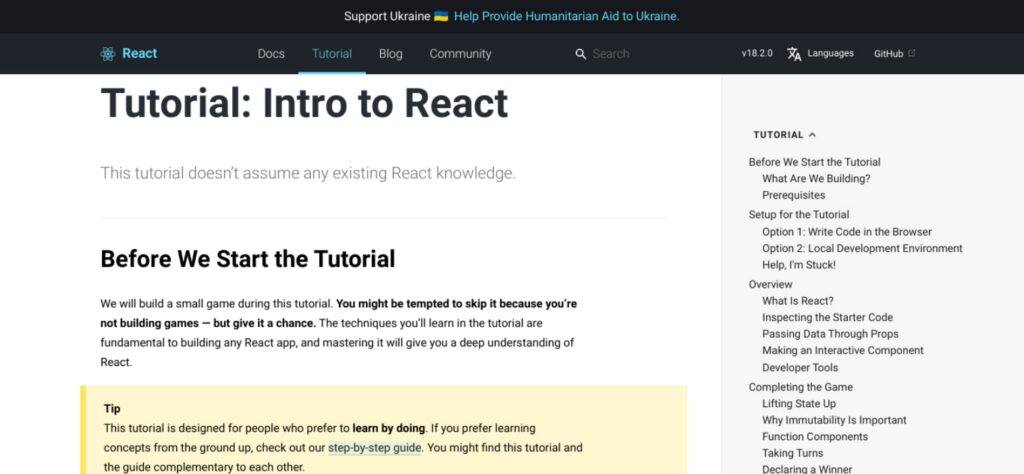
Here, you’ll find an introductory lesson on React. It starts by walking you through the process of building a small game. Throughout it, you’ll learn the fundamental techniques needed for constructing a React application.
It’s an excellent option if you’re someone who learns by doing. In addition to teaching you the fundamentals (components, props, and state), it will also cover the most important React development techniques and provide you with a more comprehensive understanding of the React benefits.
Under the Docs tab on the website, you can also find tons of helpful resources, tools, and article guides. You can browse them based on specific topics and goals, such as adding React to a website, using it to create an app, and learning advanced concepts.
2. Codecademy
Codecademy is a website that offers interactive courses on various programming languages, like React:
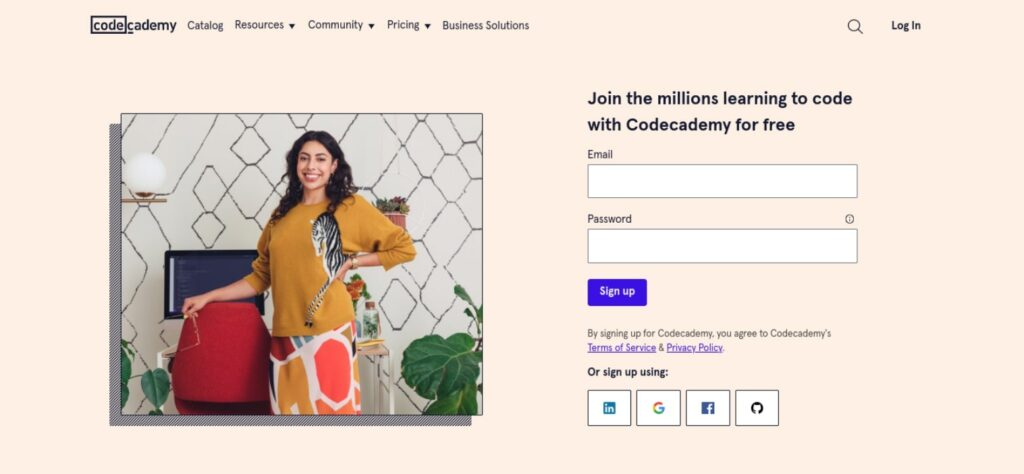
The courses are self-paced, so you can work through them at your own speed. More specifically, Codecademy offers a Learn React course on building front-end applications:
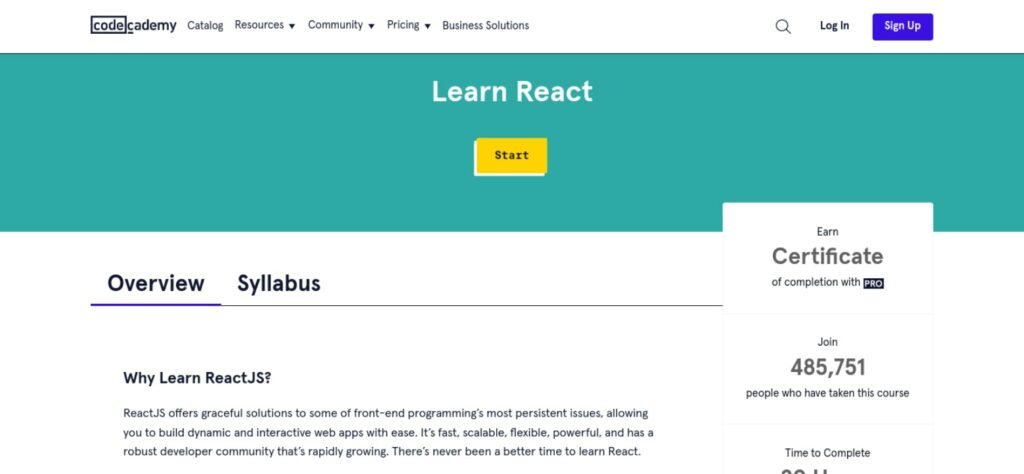
The Codecademy React course covers the basics of React, including how to create components, props, and states. Additionally, the course teaches you how to use React with JavaScript and how to build a simple front-end application with React. After you’ve completed this course, you should be able to build simple React applications.
The course is free to take, but it does have a monthly subscription fee if you want access to the full range of features. With the pro plan, you can earn a certificate upon completion. It takes approximately 20 hours to complete.
3. FreeCodeCamp.org
Free Code Camp is another great resource for developers who want to learn how to code without spending any money. It offers a Learn ReactJS – Complete Roadmap guide on building front-end applications with React:
Alt text: The Freecodecamp.org website.
This is a great option for beginners, since it goes over what to learn before. It can also help you progress from being an intermediate React developer to an advanced one. You can use this guide as a map of your learning experience. It is also packed with helpful tutorials and resources for every step of the learning journey.
4. Udemy
Udemy is a popular platform that provides a wide range of online learning paths on various subjects. It has over 3,000 courses on React:
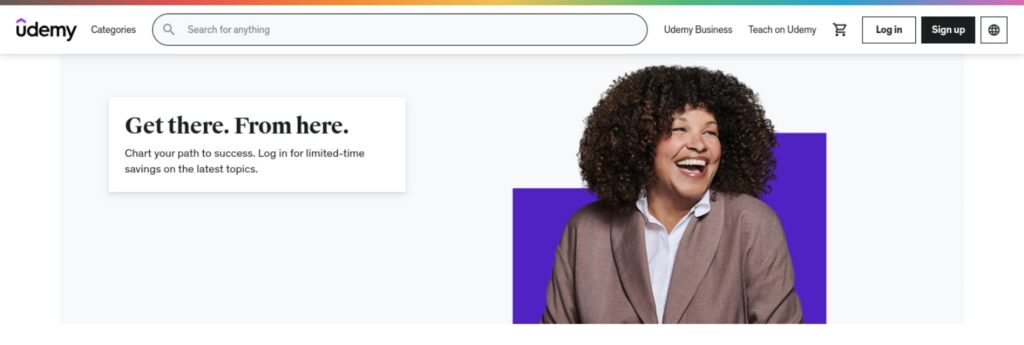
Some are a bit outdated and particularly short. However, there are plenty of solid options worth checking out, such as React JS Frontend Web Development for Beginners:

This free course will teach you the basics of hooks and working with external Application Programming Interfaces (APIs). It can also show you how to make AJAX requests and how to build a news app.
Udemy’s free courses all include nearly three hours of online video content. However, paid memberships are also available. With a paid plan, you can get a certificate of completion, plus instructor Q&A and direct messages.
5. Egghead.io
Egghead.io is great resource for learning React:
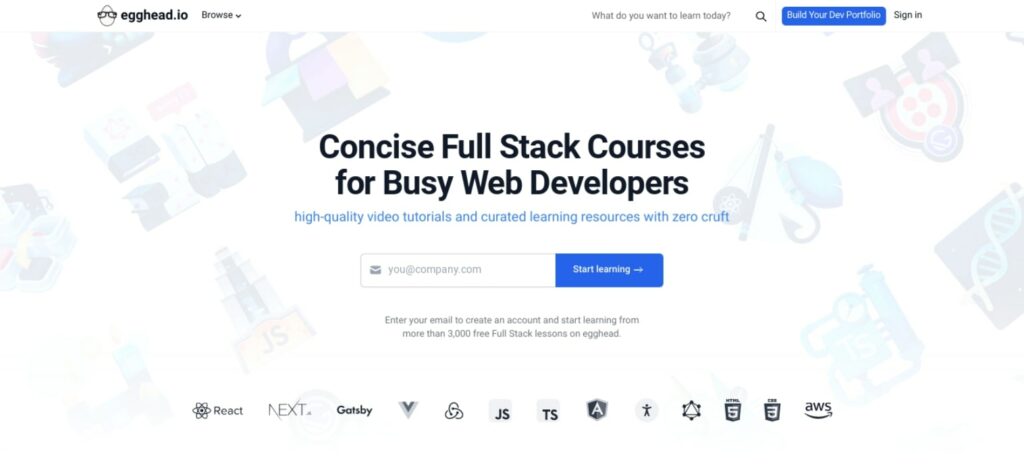
It offers a number of video courses that cover various topics related to React. One of the most popular is The Beginner’s Guide to React:
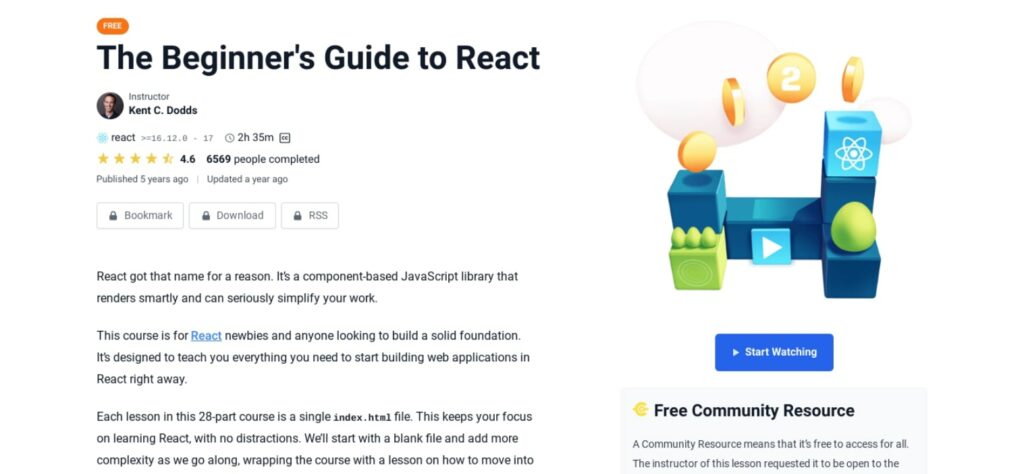
This is a free, hands-on course that teaches you how to build smart websites with ReactJS. The course is composed of 28 parts, with each lesson in a single index.html file. This provides a distraction-free learning environment that lets you develop your skills in a focused, streamlined manner.
The course begins with a blank file, then gradually grows more complex as you progress through the lessons. At the end, you’ll learn how to move to a product-ready environment and deploy your application.
Additionally, the course teaches you what problems React can solve and how to work them out. It also explains what JSX is and the role it plays in standard JavaScript objects and function calls. In this course, you’ll also learn how to manage state with hooks and build forms.
6. Coursera
Another popular online learning platform to consider for learning React is Coursera:

The professional courses on this website are created by highly accredited universities across the globe. One of the most helpful React courses is Front-End Web Development with React:
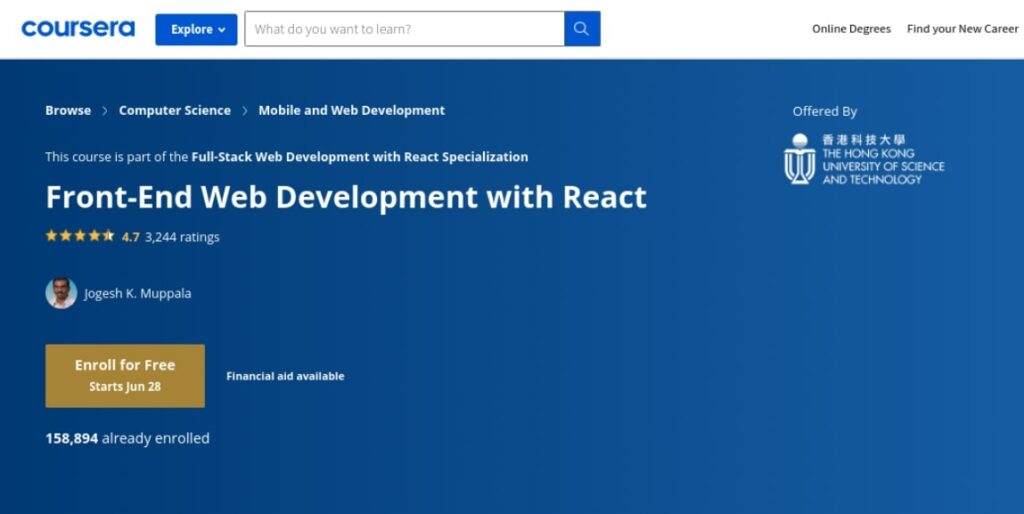
This premium course teaches you fundamental concepts as well as more advanced methods, such as React routing, designing single-page applications, how to use the REST API, and using Redux for client-server communication. Offered by The Hong Kong University of Science and Technology, this course is a bit more formal than other options.
However, it delivers comprehensive, detailed lessons that can help you advance to the next step of your React knowledge. By the end of the course, you’ll be familiar with client-side JavaScript application development and the React library. You’ll also be able to:
- Use various React features including components and forms.
- Implement a functional front-end web application using React.
- Utilize Reactstrap for designing responsive React mobile applications.
- Use Redux to design the architecture for a React-Redux application.
You also have multiple options for joining the course. As a standalone course, you can pay a monthly fee. However, if you join Coursera Plus, the course is included. You’ll also receive a professional certificate upon completion and unlimited access to other courses.
7. Scrimba
Scrimba is a powerful platform for learning how to code:
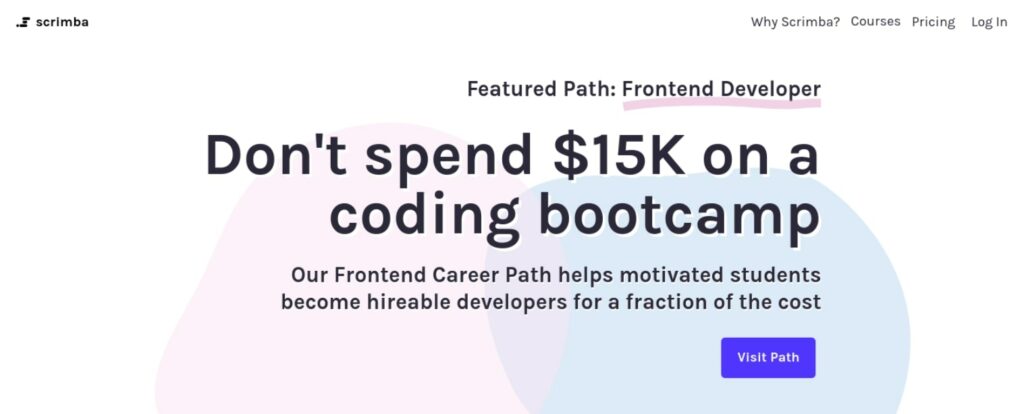
It offers thousands of paths and courses that can help you learn React Native, React app building, and much more. One of the courses we recommend is Learn React:
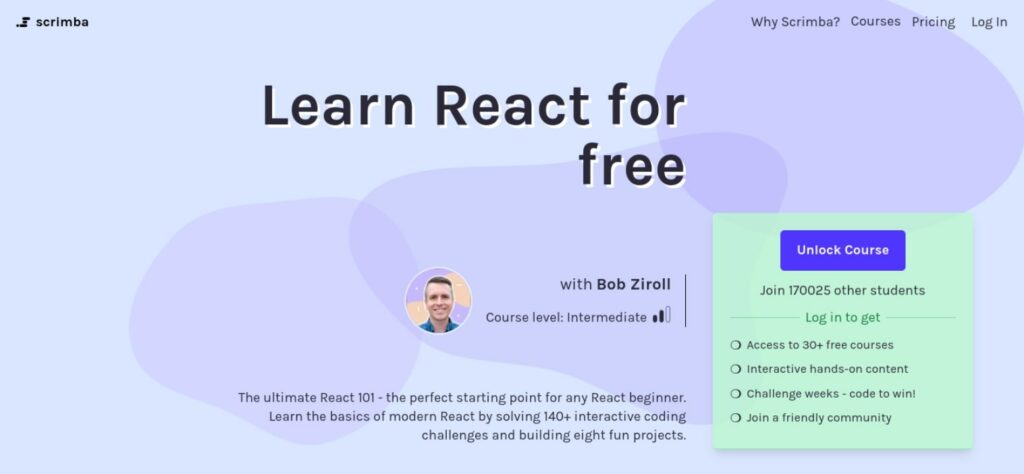
This interactive course is an excellent resource for beginners. It teaches the basics of modern React and offers lessons that require you to solve more than 140 coding challenges. You’ll build eight projects and explore 147 screencasts across four modules.
Throughout the course, you can take multiple paths. For example, you can learn how to build a React information site in two and a half hours. You can also learn how to build a meme generator or create an AirBnB experience website.
8. Facebook Create-React-App
Facebook’s create-react-app is a tool that can be used to create a boilerplate React application:
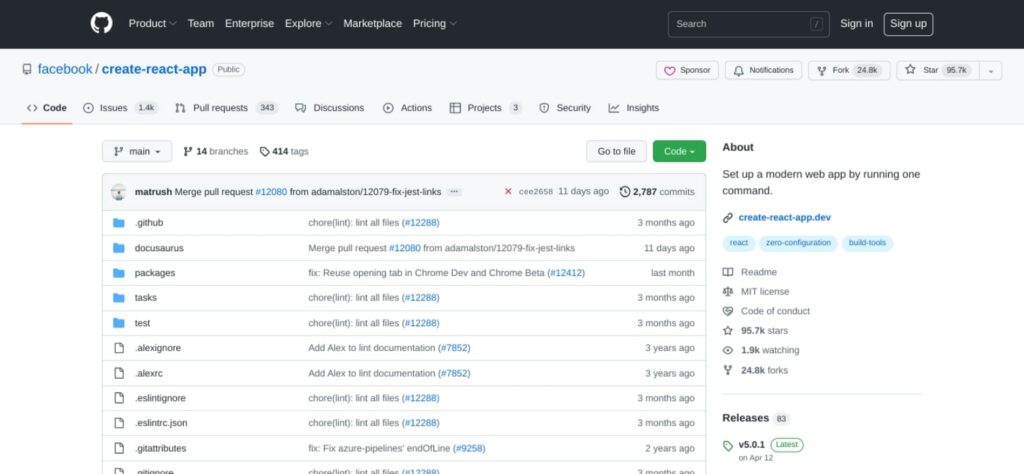
Available on GitHub, this resource for developers lets you get started with React quickly. It teaches you how to create a new app and develop apps bootstrapped with it, with no build configuration.
You can use it on macOS, Windows, and Linux. In addition to being completely free, you also don’t need to worry about installing or configuring tools such as Webpack or Babel. You can simply create a project to get started.
Start Learning React Today
React is an excellent JavaScript library that is useful if you’re interested in front-end programming. It offers a simplified approach to building complex UIs without having to write a lot of code. Fortunately, there are plenty of platforms and resources available to help you learn React for relatively cheap (sometimes even free).
As we discussed in this post, once you have JavaScript, HTML, and CSS experience, there are a handful of ways you can learn React. Some of the most popular resources to check out include the React official website, Codecademy, and FreeCodeCamp.org.
Are you looking for an affordable yet reliable hosting solution for your web development projects? Check out DreamHost shared hosting plans to get started!
Website Hosting That Powers Your Purpose
We make sure your website is fast, secure and always up so your visitors trust you. Plans start at $1.99/mo.
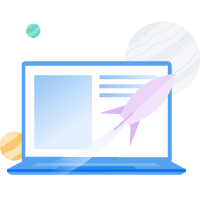
The post How to Learn React… Fast appeared first on Website Guides, Tips & Knowledge.
source https://www.dreamhost.com/blog/learn-react/

No comments:
Post a Comment